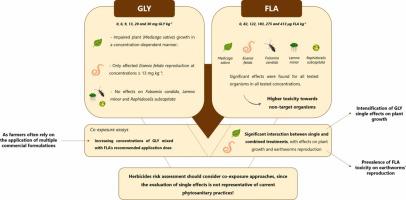Journal of Hazardous Materials ( IF 12.2 ) Pub Date : 2022-10-05 , DOI: 10.1016/j.jhazmat.2022.130128 Cristiano Soares 1 , Beatriz Fernandes 2 , Cristiana Paiva 1 , Verónica Nogueira 3 , Anabela Cachada 3 , Fernanda Fidalgo 1 , Ruth Pereira 1

|
Glyphosate (GLY) and flazasulfuron (FLA) are two non-selective herbicides commonly applied together. However, research focused on their single and combined ecotoxicological impacts towards non-target organisms is still inconclusive. Therefore, this study aimed to test their single effects on soil’s habitat and retention functions, and to unravel their combined impacts to earthworms and terrestrial plants. For this, ecotoxicological assays were performed with plants (Medicago sativa), oligochaetes (Eisenia fetida) and collembola (Folsomia candida). Soil elutriates were also prepared and tested in macrophytes (Lemna minor) and microalgae (Raphidocelis subcapitata). FLA (82-413 µg kg-1) reduced earthworms’ and collembola’s reproduction and severely impaired M. sativa growth, being much more toxic than GLY (up to 30 mg kg-1). In fact, the latter only affected plant growth (≥ 9 mg kg-1) and earthworms (≥ 13 mg kg-1), especially at high concentrations, with no effects on collembola. Moreover, only elutriates from FLA-contaminated soils significantly impacted L. minor and R. sucapitata. The experiments revealed that the co-exposure to GLY and FLA enhanced the toxic effects of contaminated soils not only on plants but also on earthworms’. However, such increase in toxicity was dependent on GLY residual concentrations in soils. Overall, this work underpins that herbicides risk assessment should consider herbicides co-exposures, since the evaluation of single exposures is not representative of current phytosanitary practices and of the potential effects under field conditions, where residues of different compounds may persist in soils.
中文翻译:

草甘膦和啶嘧黄隆与土壤生境和保留功能的生态毒理学相关性——单一暴露与联合暴露
草甘膦(GLY)和啶嘧磺隆(FLA)是两种通常一起使用的非选择性除草剂。然而,针对其对非目标生物的单一和综合生态毒理学影响的研究仍然没有定论。因此,本研究旨在测试它们对土壤栖息地和保留功能的单一影响,并揭示它们对蚯蚓和陆生植物的综合影响。为此,对植物( Medicago sativa) 、寡毛类动物( Eisenia fetida )和跳虫( Folsomia candida )进行了生态毒理学测定。还制备了土壤淘洗液,并在大型植物(青萍)和微藻( Raphidocelis subcapitata )中进行了测试。 FLA (82-413 µg kg -1 ) 会减少蚯蚓和跳虫的繁殖,并严重损害苜蓿的生长,其毒性比 GLY(高达 30 mg kg -1 )高得多。事实上,后者仅影响植物生长(≥9 mg kg -1 )和蚯蚓(≥13 mg kg -1 ),特别是在高浓度下,对弹尾虫没有影响。此外,只有来自 FLA 污染土壤的淘析物才对L.minor和R.sucapitata产生显着影响。实验表明,同时接触 GLY 和 FLA 不仅会增强受污染土壤对植物的毒性作用,还会增强对蚯蚓的毒性作用。然而,这种毒性的增加取决于土壤中 GLY 的残留浓度。 总体而言,这项工作强调除草剂风险评估应考虑除草剂共同暴露,因为单次暴露的评估不能代表当前的植物检疫做法和田间条件下的潜在影响,在田间条件下,不同化合物的残留可能持续存在于土壤中。











































 京公网安备 11010802027423号
京公网安备 11010802027423号